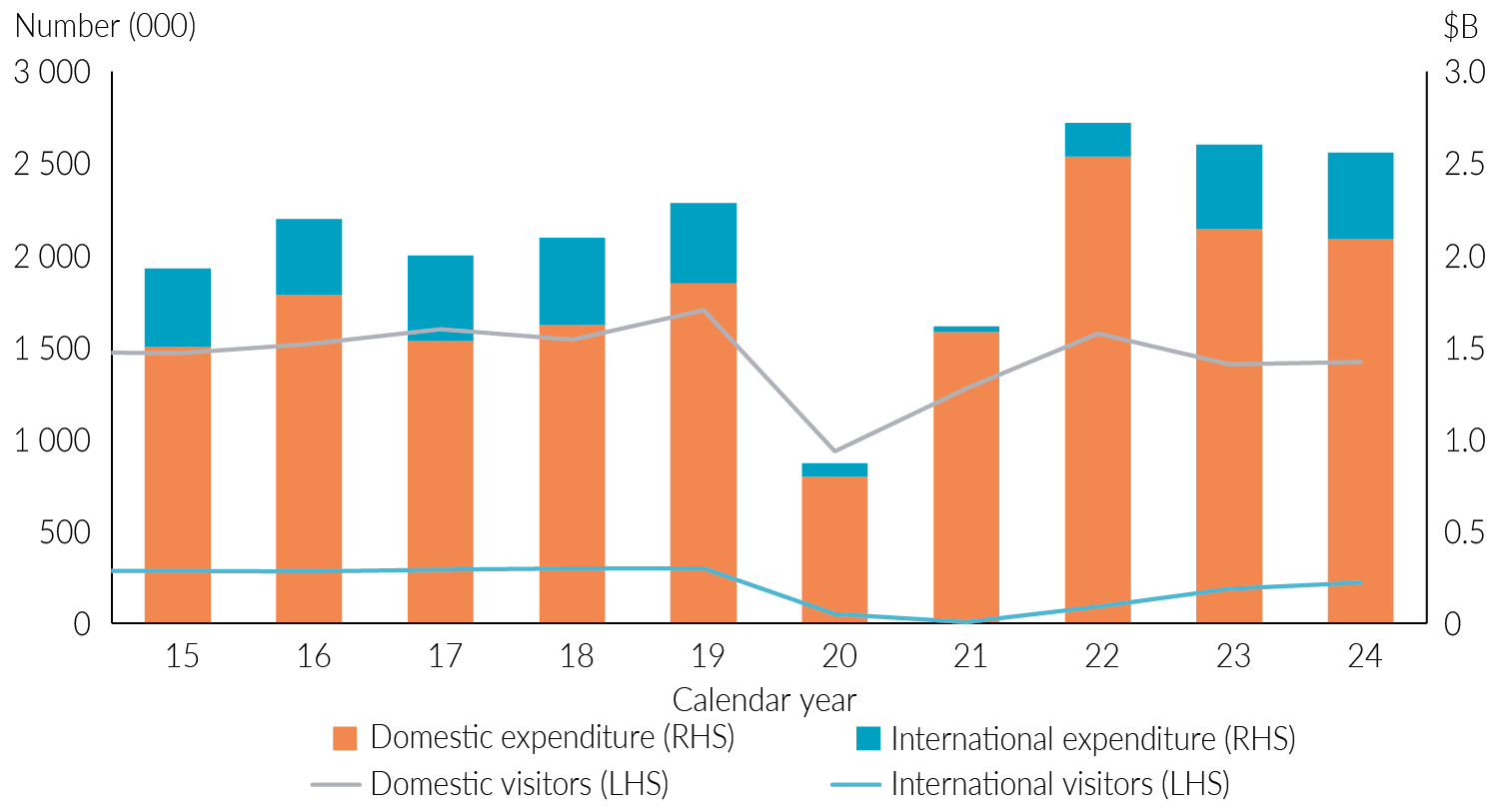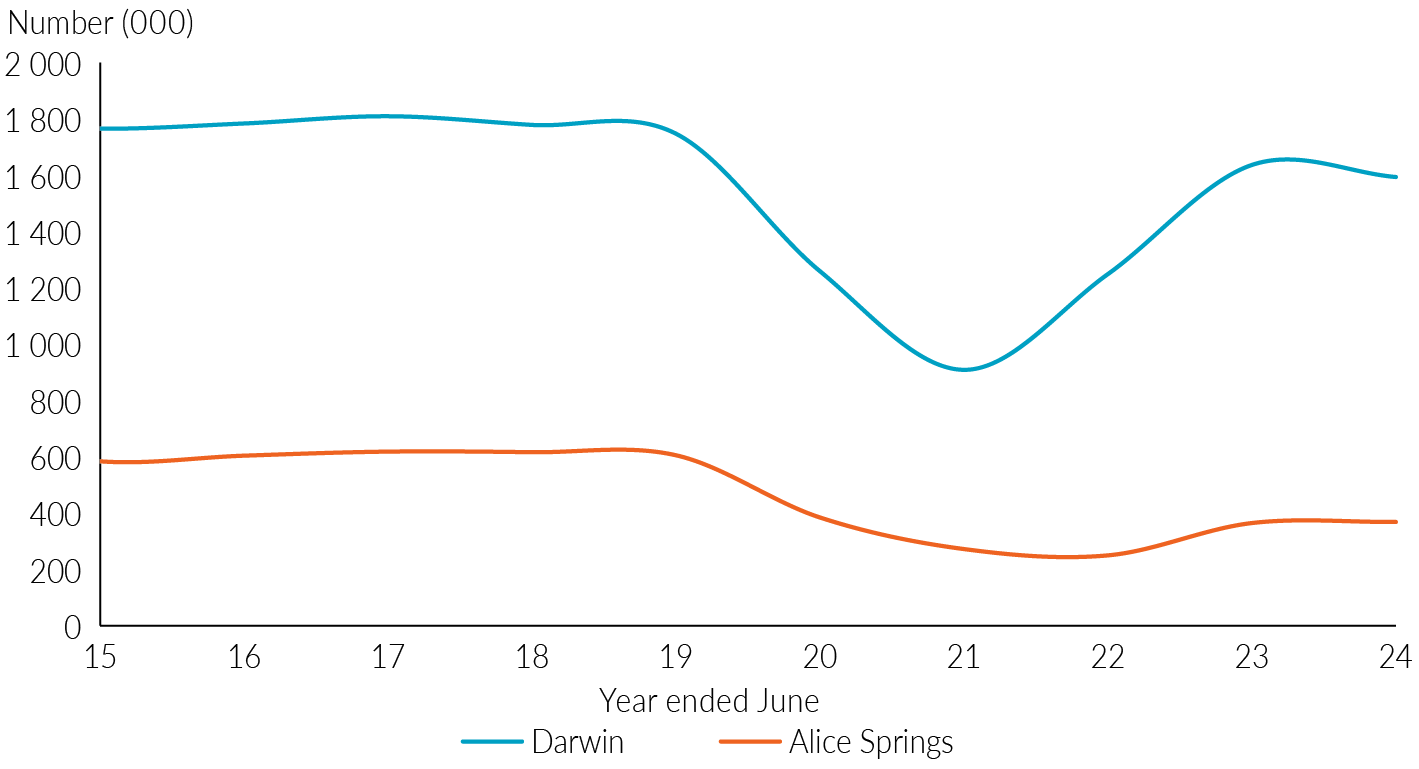Tourism
Outlook
Tourism visitation continues to recover slowly from the covid pandemic. Over the medium term, tourism is expected to gain from growth in international visitation. The long-term outlook remains positive as the industry continues to recover to pre covid levels.
Tourism is an important economic driver for the Territory and a significant industry in regional areas. In 2023-24, the tourism sector accounted for 3.7% of GSP, contributing $1.2 billion, and 5.1% of total employment with about 8,000 jobs. The number of visitors to the Territory increased by 2.9% to 1.6 million visitors in 2024 with a 0.9% increase in domestic and a 17.6% increase in international overnight visitation. Visitor expenditure remained steady in 2024. The growth in international visitation was supported by marketing activities and measures such as The Territory Aviation Attraction Scheme (TAAS), catering to both domestic and international flight travel. The outlook for tourism remains positive over the long term as the industry continues to recover post covid.
Chart 13: International and domestic visitation and expenditure in the Territory1
LHS: left-hand side; RHS: right-hand side
1 Moving annual total.
Source: Tourism Research Australia, National Visitor Survey
Domestic and international overnight visitations were 16.5% and 25.9% below pre pandemic levels in 2024, respectively.
International visitation
There were 221,000 total international visitors to the Territory in 2024 (33,000 more than the previous year). Despite growth rising post covid, the recovery of international visitation to pre-covid levels has been challenging due to limited flight routes into the Territory and increased competition from other tourism destinations globally.
In 2024, 159,000 international visitors came to the Territory to holiday, while 31,000 came to visit a friend or relative. About 11,000 visitors came for business purposes, while 29,000 visited for other reasons. Holiday visitation was a key driver in the Territory, comprising about 72% of total international visitation in 2024.
The Territory’s travel sector has been affected by outbound travel, which has stabilised at high levels throughout 2024. There is strong competition for international visitors in global tourism industries due to international events and festivals, especially in European countries during summer. Due to this, the gap between inbound and outbound visitors in the Territory has been widening.
Domestic visitation
In 2024, there were 1.4 million domestic visitors to the Territory, up 0.9% from 2023 with the average domestic visitor spend around $1,471 per trip, down 3.3% from 2023. Domestic visitor numbers continue to reflect shifts in consumer behaviour and the impact of higher airfares. In addition, competition in the global market for tourism, with a range of destinations ramping up their investment to attract potential travellers have contributed to the slow growth in domestic visitation.
Domestic visitation to the Territory remains below pre-covid levels but is continuing to recover. The number of domestic visitors increased by 11.3% from 2021 to 2024, while average visitor expenditure improved by 18.6%. About 525,000 holiday visitors came to the Territory in 2024, making up 36.9% of total domestic visitors. The number of interstate visitors increased by 19% to 912,000, which remains below pre‑covid levels, down by 15.5%.
Business travel to the Territory is recovering at a steady pace, with a better rate of recovery than holiday travel. In 2024, there were 590,000 business travellers to the Territory, up 28.6% from 2023, and 13.9% below pre-covid levels. Many businesses have maintained practices that were adopted during covid, such as virtual conferences instead of face-to-face meetings, dampening the demand for business travel.
The Territory faces strong competition from international destinations for visitation. In the long term, the tourism industry will also be supported by improvements in domestic visitation as more frequent flight routes are established.
Government initiatives
In 2025-26, the Territory Government is investing $88.3 million in tourism, events and screen production.
This includes an ongoing $8 million increase to the tourism base budget, instilling confidence in a forward-looking sector, with a focus on:
- realigning international marketing strategies to boost visitor numbers from established markets such as the United States, United Kingdom and Germany, while maintaining trade education initiatives in emerging markets like China and Southeast Asia
- partnerships with airlines and trade partners to enhance seat demand and raise awareness of the diverse offerings of the Territory, both nationally and internationally
- development of a Visitor Economy Strategy that would bring a clear focus on all drivers of visitation, including events and hospitality
- updating the NT creative marketing efforts to enhance awareness of the diverse aspects of the Territory as a holiday destination
- incorporating business events, major sporting and cultural events, and domestic and international screen opportunities into NT’s destination promotion strategies, itineraries, and trade-ready bookable products
- development of a robust strategy for visitors to appreciate and experience the Territory’s rich military heritage
- supporting the continued operation of the Visitor Information Centre at Yulara, and maintaining the Visitor Information Centre network in Darwin, Katherine, Tennant Creek and Alice Springs
- prioritising and enhancing Parks tourism assets as drivers of visitation to the Territory.
Along with the ongoing boost to base funding, the Territory Government is investing in a number of projects that will help support the tourism sector across the Territory in 2025-26. These include:
- $3 million in the second year of the five-year partnership agreements in place with the regional tourist associations, Tourism Top End and Tourism Central Australia, and the Katherine Town Council to support visitor information services and intra-Territory marketing initiatives
- $1.1 million for Aboriginal tourism industry development that inspires visitors to connect with one of the world’s oldest cultures and ensures Aboriginal people of the NT are supported to benefit economically, socially and culturally
- $3 million in Visitor Experience Enhancement Program grants to assist the tourism industry to undertake projects that improve the on ground visitor experience in the Territory, spanning over three streams, namely, new product and experience enhancement, military heritage tourism, and upgrading and enhancing existing offerings, each with a $1 million funding pool
- cooperative marketing with airlines to support the long-term sustainability of aviation services to the Northern Territory.
Accommodation
In 2024, the average visitor spent 7.3 nights in the Territory, up 0.4 nights from the previous year. The Northern Territory Monthly Accommodation Report outlines the accommodation sector in the Darwin and Alice Springs regions. In 2024, hotels experienced a marginal decline in bookings, with occupancy rates declining by 0.3 percentage points to 57%, relative to 2023. The hotel sector experienced a decline in supply, down 0.4% to 3.4 million room nights, and a decline in demand by 0.1% to 1.9 million room nights.
In 2024, the short-term letting sector experienced an increase in bookings, with occupancy rates increasing by 3.0 percentage points to 57%, relative to 2023. The short-term letting sector experienced a decline in supply of 3.1%, to 247,000 room nights, and an increase in demand of 1.4% to 146,000 room nights.
The hospitality sector was significantly affected by staff shortages in 2024. This indicates a widespread issue across various hospitality segments from restaurants and cafés to hotels and resorts. Attracting workers post-covid has been challenging. However, measures such as the Working Holiday Maker campaign by the Territory Government and Tourism NT aims to attract international workers and backpackers aged between 18 and 35 years, encouraging more travel to the Territory to create a stronger workforce.
Access
Aviation services directly support the Territory’s economic development and underpin essential services such as healthcare, education, social welfare and movement of time-critical freight. It also plays an important role in keeping the Territory’s remote communities connected throughout the year, particularly those experiencing road closures during the wet season. The Territory’s expansive and isolated geography means there is a high reliance on air travel when commuting intrastate, interstate and internationally.
In 2023-24, domestic flights to the Territory remain below pre-covid levels, with over 1.6 million passengers flying through Darwin (down 2.6% from 2022-23) and 367,500 passengers through Alice Springs (up 1.1% from 2022-23) (Chart 14). Relative to 2018-19, flight routes are down 6.2% and are expected to recover once international markets fully return to the Territory. Aviation recovery in Central Australia has been slower than in the Top End due to its higher reliance on international visitation.
Aviation access in the Territory has been challenged in recent years by frequency of flights, choice of airlines and supply-side issues due to lack of airplanes and crews. Runway works at Darwin Airport have continued throughout 2024, with new works on military aprons being undertaken in 2025. However, runway works at Darwin Airport are not expected to affect airline flight schedules, especially with airlines having adjusted their schedules and having introduced measures to mitigate impacts on operations.
In July 2023, the TAAS became available for eligible airports to apply for funding to assist with rebates on aeronautical charges, which are passed onto consumers by airlines. The TAAS has delivered new flight routes and additional capacity across the Territory by reducing barriers to establishing new routes. The Territory Government secured a number of new airline routes during 2024-25, such as Airnorth’s direct flights from Alice Springs to Perth, Jetstar’s new direct seasonal flight between Darwin and the Gold Coast, Airnorth’s flight from Alice Springs to Cairns, Indonesia Air Asia’s flight from Darwin to Denpasar and AirAsia Malaysia’s direct service between Kuala Lumpur and Darwin. All are expected to support visitation and place downward pressure on airfares.
Chart 14: Annual passenger movements
Source: Bureau of Infrastructure and Transport Research Economics, Domestic aviation activity
Encouraging visitation during the off season is important for the recovery of flight routes and visitation to the Territory. Cooperative marketing campaigns are undertaken with all domestic and international airlines to promote air routes into the Territory and drive demand in off-peak periods.
The Territory Government continues to prioritise cruise tourism growth in the Territory while promoting Darwin as the preferred cruise gateway. After a year of significant growth in cruise tourism in the previous year, the Territory generated $181 million in total activity and supported 527 jobs from cruise ship visiting in 2024, with Darwin serving as the primary port. In 2023-24, over 100 cruise and expedition ships visited Darwin, with a total passenger capacity of 80,000 persons.
For the latest data on the tourism sector, refer to the Territory Economy website.


